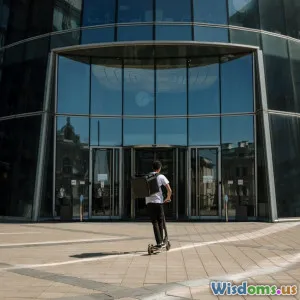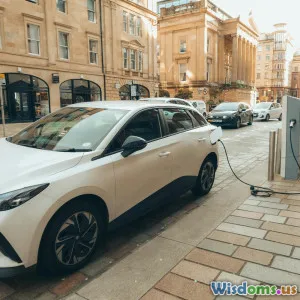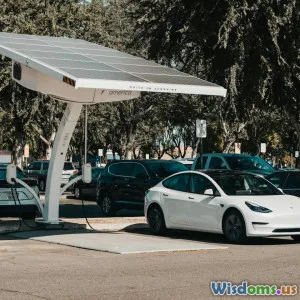
Mobility Trends Shaping Our Cities
8 min read Explore how transformative mobility trends are redefining urban life and shaping the cities of tomorrow. (0 Reviews)
Mobility Trends Shaping Our Cities
Cities are at a crossroads in mobility innovation. As urban populations swell and environmental concerns escalate, the ways we move within cities are rapidly evolving. The transport landscape is transforming from traditional car dependency to a dynamic, tech-driven ecosystem prioritizing sustainability, accessibility, and efficiency.
In this article, we explore the pivotal mobility trends influencing city living and urban planning today.
Electric Vehicles: Driving Green Urban Transformation
The shift to electric vehicles (EVs) has arguably become one of the most impactful mobility trends globally. Cities from Oslo to Shenzhen are spearheading the movement toward EVs. In Oslo, over 70% of new car sales in 2023 were electric, largely influenced by generous subsidies, access to bus lanes, and extensive charging infrastructure.
Why does this matter? Electric vehicles significantly reduce urban air pollution by cutting tailpipe emissions—a crucial factor since the World Health Organization links air pollution to millions of premature deaths annually. For urban centers grappling with smog and health issues, EV adoption presents a clear path to cleaner air.
More than passenger cars, electrification extends to buses, taxis, and delivery fleets, which form a backbone of city mobility. Cities like Los Angeles aim for 100% zero-emission public buses by 2030, projecting notable declines in urban nitrogen oxide and particulate pollution.
Micro-mobility and Shared Mobility: Reinventing Last-Mile Travel
Another transformative trend is the rise of micro-mobility solutions—electric scooters, bikes, and shared pedal cycles—which tackle the notorious “last-mile” challenge. Last-mile refers to the gap between mass transit hubs and final destinations that people often cover by car or walking.
Companies like Lime and Bird have flooded many urban centers with dockless electric scooters, providing an affordable and convenient travel option for short commutes. Cities such as Paris experienced a 30% increase in bike share trips after upping cycling infrastructure investment and integrating micro-mobility with metro services.
Shared mobility platforms also extend beyond scooters. Car-sharing services like Zipcar and peer-to-peer options reduce private car ownership rates and traffic congestion. For example, research from the University of California found that one shared car might replace up to 15 privately owned vehicles in urban areas.
Autonomous Vehicles: The Promise and Challenges
Autonomous vehicles (AVs)—cars that operate without human drivers—promise a profound reshape of urban transportation. AVs can optimize traffic flow, reduce accidents led by human error, and enable mobility for all, including older adults and persons with disabilities.
Cities such as Phoenix and Singapore are running pilot projects deploying autonomous shuttles along designated routes. Singapore’s Smart Mobility 2030 roadmap foresees widespread AV integration paired with advanced traffic management systems and connectivity.
Despite their promise, AVs face formidable hurdles: regulatory complexity, infrastructure demands, cybersecurity concerns, and public acceptance must be addressed. Well-planned trials combined with policies prioritizing equitable deployment will be essential as this technology matures.
Mobility-as-a-Service (MaaS): Seamless Urban Travel Integration
MaaS refers to integrating various transport modes into a single user-friendly digital platform, enabling travelers to plan, book, and pay for multi-modal trips effortlessly—from buses, trains, bikes, taxis, to ride-shares.
Platforms like Whim (in Helsinki) and Moovit (global) exemplify MaaS by uniting transit information in real-time, empowering users to select the fastest or cheapest option on-demand. MaaS adoption reduces dependency on private vehicles, boosting the use of public transit and micro-mobility.
The success of MaaS hinges on collaboration among transit agencies, tech startups, and regulators. Data sharing safeguards and transparent pricing models increase user trust, essential for mass adoption.
Urban Design and Smart Infrastructure: Foundations for Future Mobility
Emerging vehicle technologies and travel behaviors herald a parallel imperative: rethinking urban design. Cities increasingly adopt "complete street" principles that prioritize safe access for all users, including pedestrians, bicyclists, public transport passengers, and drivers.
For example, Barcelona’s "Superblocks" program supports car-restricted zones reclaiming streets for community use—reducing noise, improving air quality, and encouraging walking and cycling. Such urban design initiatives complement technological trends, magnifying their benefits.
Moreover, smart infrastructure investments, such as connected traffic signals, EV fast-charging stations, and digital signage, enable cities to optimize transport networks dynamically and accommodate fluctuating demand efficiently.
The Societal Impact: Equity and Accessibility Matters
While technology drives the future, mobility is fundamentally about people. Ensuring equitable access to improved mobility options is paramount.
Historically, marginalized communities have suffered from inadequate transport services and environmental burdens. Mobility innovations should prioritize affordability, geographic coverage, and user-friendly design to avoid exacerbating existing disparities.
Inclusive planning involves community engagement and partnerships with non-profits. Initiatives such as subsidized transit fares or discounted bike-share memberships enable low-income residents to fully participate in new mobility ecosystems.
Conclusion: Shaping Sustainable and Inclusive Cities through Mobility
The mobility trends shaping our cities weave a complex but exciting narrative of change—actively transitioning urban transportation toward greener, smarter, and more connected systems. Electric and autonomous vehicles, micro-mobility, MaaS, innovative urban design, and a focus on equity converge to craft sustainable futures.
Cities that embrace these trends strategically, supported by thoughtful policies and robust infrastructure, stand to dramatically enhance residents' quality of life, combat climate change, and unlock economic growth.
Mobility isn't just about getting from point A to B—it’s an engine for urban transformation. The question for city leaders, planners, and citizens is how to harness these trends responsibly to build vibrant, accessible, and resilient urban spaces that welcome everyone.
In essence, understanding and participating in shaping mobility trends is not merely desirable but essential for our cities’ future well-being.
Rate the Post
User Reviews
Popular Posts





















